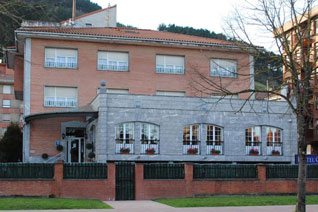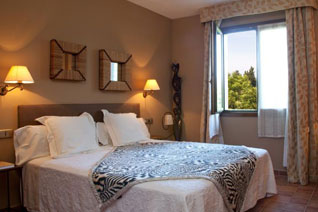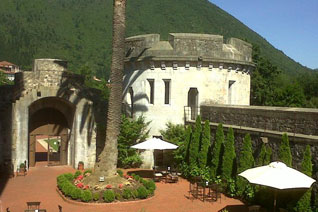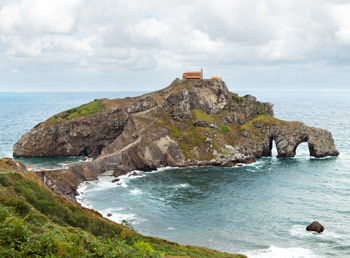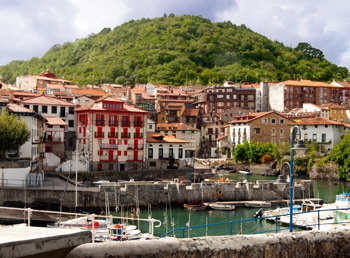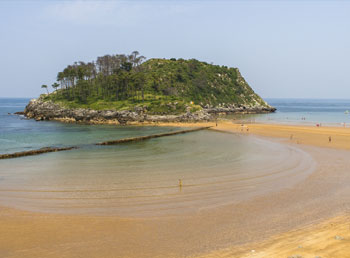Guernica Tree & Biscayan Assembly
Two of the most important political symbols of the Basque Country can be found in Guernica – the Biscayan Assembly House (Casa de Juntas) & the Guernica Tree (Árbol de Gernika). This is due to the fact that both of these locations are where the Lords of Biscay and Basque politicians have meet to decide the fate of the Basque people.
Throughout the Middle Ages in Europe, it was common for leaders of various communities to come together under a tree to create laws and make agreements. The Guernica Tree is one such tree that was used as a meeting point for the Basque communities and the Lord of Biscay.
It was beneath its branches where the Lords of Biscay swore to respect the Biscayan liberties and where they established a set of laws known as “fueros,” that granted the Basques autonomous rule. The fueros were granted by every Lord of Biscay and eventually the King of Castile until the end of the 19th century when the Carlist Wars began.
For these reasons, the Guernica Tree has become a symbol of Basque identity and worked as a catalyst for the Basque independence movement.
Today, the Spanish Basque Country enjoys a certain amount of autonomous rule granted by the Spanish government. They even have their own president known as the lehendakari who still takes his oath under the Guernica Tree in a similar fashion as was once done by the Lords of Biscay.
The first documented Guernica Tree dates back to the 14th century. However, the oak tree that can be seen today, standing in front of the oath tribune, has been planted in 2015.
The remains of an older Guernica Tree can also be found in the gardens that surround the Biscayan Assembly. This “old tree,” planted in 1742, is also not the original Guernica Tree but is the oldest one that still partially stands today.
The building that stands next to the Guernica Tree is home to the Biscayan Assembly. It was designed by the architect was Antonio de Etxebarria between 1826 and 1833 in neoclassical style.
Its main room is the Assembly Hall and its here where the politicians from Biscay meet. The room is beautifully decorated with paintings of the different Lords of Biscay and some elements from the church that stood in that same place previously, the hermitage of Santa María de la Antigua.
There is another impressive room in the Biscayan Assembly House, the so called Stained Glass Room. As its name indicates, the highlight of this room is the enormous stained glass that covers the entire ceiling. It depicts the Guernica Tree and the history of the assemblies.
Guernica Bombing & Painting by Picasso
During the Spanish Civil War (1936 - 1939), Guernica was considered to be the northern bastion of the Republican resistance and the center of Basque culture. For this reason, it became a prime target for Francisco Franco.
On the 26th of April 1937, under Franco's orders, German and Italian air forces bombed Guernica, turning it into a pile of rubble. The attack took place on a Monday – market day. However, the market, which was usually packed, wasn’t too busy. This is because the mayor had already ordered it to be closed by noon due to fact that the war front was approaching Guernica.
The bombing that started around 4 pm, sent people fleeing to the mountains and to the various bunkers that had been built within the town. Many civilians lost their lives. Although the exact number is still unknown today, both witnesses and experts agree that at least 1,000 people died.
One thing is for sure though – the town was severely devastated. Of the town’s buildings, 85% were completely destroyed. However, the Biscayan Assembly and the Guernica Tree survived. Interestingly enough, the bridge that was the official target of the bombing remained intact.
This horrendous bombing inspired the famous painting “Guernica” by Pablo Picasso, of which you will find a full size ceramic reproduction on the Pedro de Elejalde Street. Picasso painted “Guernica” only a couple of months after the attack. The artwork was requested on behalf of the Republican Government, whose goal was to bring the Spanish Civil War to the attention of the rest of the world.
While “Guernica” does not contain any direct reference to the bombing it does show suffering and destruction. The painting has gained monumental status and serves as a reminder of the tragedies of war.
After its completion, “Guernica” traveled extensively throughout Europe where it quickly rose to fame. So much so, that even Hitler sought to acquire it and destroy it. The painting makes a very strong political statement and it is clear why it is now considered to be Picasso’s most famous piece.
After the end of the Spanish Civil War, “Guernica” was sent to the United States and was exhibited in an attempt to raise funds for Spanish war refugees. From 1958 to 1981 it was exhibited at the MoMa in New York until it was returned to Spain. Currently, “Guernica” can be seen at the Reina Sofía Museum in Madrid.
Guernica Market
Every Monday, people from all over the province arrive in Guernica to buy and sell local produce at the market. But the market is much more than just a place to exchange food items. More importantly, it functions as a gathering point – a place to socialize, eat some good food and maybe even watch a game of pelota.
The Monday market of Guernica is the most famous market in the Basque Country and, until not so long ago, every Monday was considered a holiday. There is even a saying in town – “Lunes gernikés, golperik ez,” which means that on Mondays in Guernica, you aren’t going to get much accomplished.
If you are interested in visiting a market in the Basque Country, it should probably be this one. Nevertheless, if you choose to visit Guernica on a Monday, keep in mind that the museums are closed.
Peace Museum
The Peace Museum is located in the center of Guernica, at the ![]() Fueros Square, right in front of the Town Hall. It is an interactive museum with an extensive photographic and audiovisual exhibition that is a testimony of the survivors from the attack that took place in Guernica on April 26, 1937.
Fueros Square, right in front of the Town Hall. It is an interactive museum with an extensive photographic and audiovisual exhibition that is a testimony of the survivors from the attack that took place in Guernica on April 26, 1937.
It first opened its doors in 1998 as a museum dedicated to the history of Guernica and the bombing. Between 1999 and 2002 the museum was renovated and it reopened its doors in 2003 as the first Peace Museum of Spain. Its mission is to conserve, expose, spread, investigate and educate the visitor about the history of Guernica and explain why a culture of peace is needed in the world today.
Euskal Herria Museum
The Euskal Herria Museum opened its doors in 1991 and is housed in the Alegría Palace which is one of the only buildings in Guernica to have survived the bombing of 1937. The palace was completely rebuilt in the middle of the 18th century and is characterized by its urban baroque style, with a masonry stone facade and three balconies bastioned by rails.
The Euskal Herria Museum is an ethnographic museum dedicated to the history and culture of the Basque Country. The exhibition tries to show visitors the meaning of its historic, political and cultural environment as well as explaining the characteristics of the Basque community.
The museum is divided in four floors, with the ground level being dedicated to the physical environment that has influenced the Basque way of life. The exhibition of the first floor shows the historic evolution of the region, presenting the events that resulted in the current politic situation.
The last two floors are dedicated to Basque culture, including information about sports, music, dance, beliefs, myths, etc. There is also an attic that is used for temporary exhibitions.
Park of the Peoples of Europe
Inaugurated in 1991 and located next to the Biscayan Assembly, the Park of the Peoples of Europe is a beautiful park that is worth taking a stroll through.
One of the highlights of the park are the sculptures from Eduardo Chillida and Henry Moore. There are also the busts of W. Humboldt and G. Bähr.
The sculpture of Chillida is called “Gure Aitaren Etxea” which means “The house of our father.” It was ordered by the Basque Government to commemorate the 50th anniversary of the Guernica bombing. It is a monument dedicated to peace and was designed so that, from its window, it is possible to see the Guernica Tree.
The sculpture by Henry Moore is entitled “Large Figure in a shelter” and is part of the collection “War Helmets,” that the artist started during the World War II.
Santa Maria Church
The Santa Maria Church stands on the highest point of Guernica. Although its construction started in 1418, it went through several modifications throughout the centuries and wasn't actually finished until 1715.
It is considered one of the best examples of gothic architecture in the Basque Country. However, due to its long construction time, there are various different architectural styles found in the building. The last style of architecture employed in the Santa Maria Church was renaissance.
The church’s main highlight can be found in its interior. There you will find a Walcker organ from 1889.
Although the Santa Maria Church wasn't destroyed by the bombing of 1937, it was seriously damaged and its parochial archive was lost in the fire that followed.
Fronton Jai Alai
The fastest sport in the world, Jai Alai, has a long tradition in Guernica. The city is proud to have the second largest active fronton in the world, called Guernica Jai Alai and considered by many professional players to also be the best fronton in the world.
Inaugurated in 1963, it was designed by Secundino Zuazo, one of the most significant architects of the 20th century in Spain.
The Guernica Jai Alai School (Gernika Jai Alai Eskola) organizes Jai Alai demonstrations for visitors. That service includes a short introduction to the history of Jai Alai, a demonstration match to 15 points and it is also possible to put a cesta on and have a go at it yourself.
There is also another fronton in Guernica called Santanape where the most popular version of pelota is played – pelota mano.





















